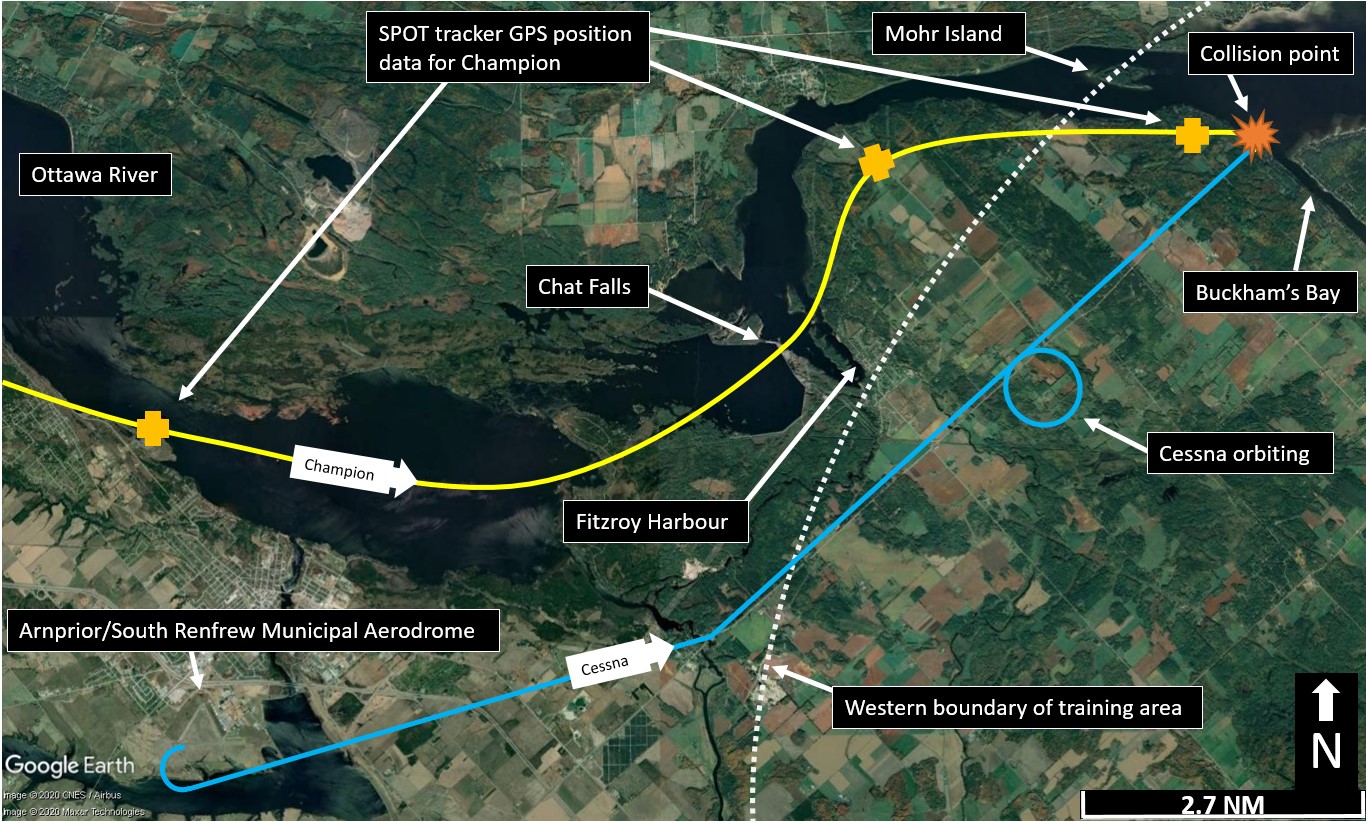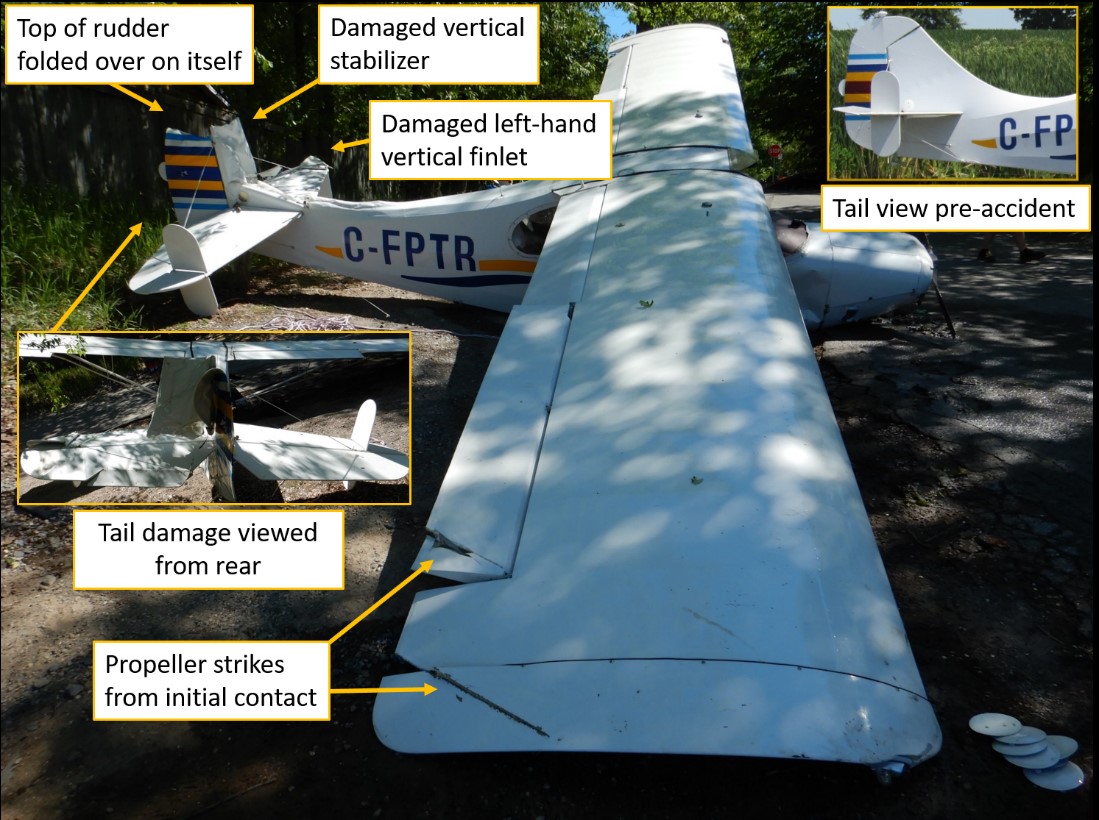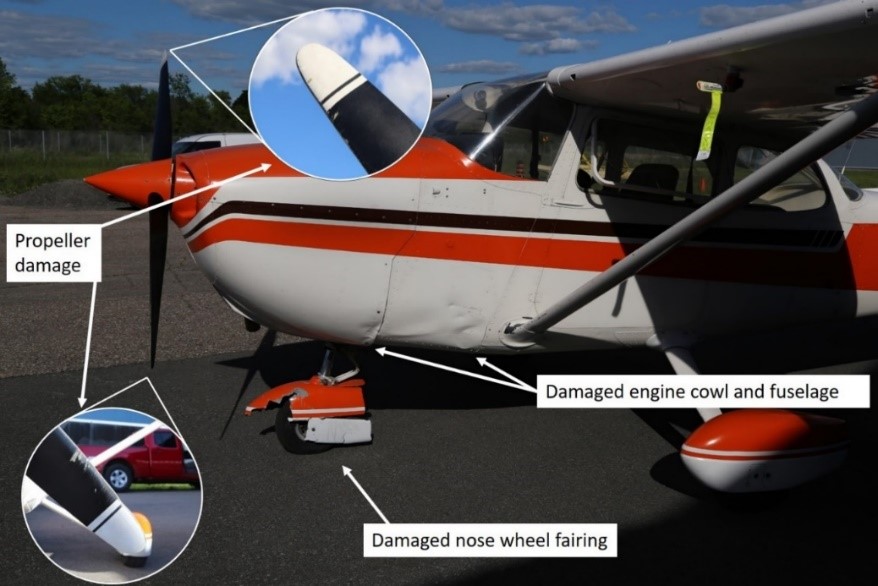Mid-air collision
Privately registered
Champion 7GCB, C-FPTR
and
Privately registered
Cessna 172M, C-GEDC
Arnprior/South Renfrew Municipal Aerodrome, Ontario, 12 NM ENE
The Transportation Safety Board of Canada (TSB) investigated this occurrence for the purpose of advancing transportation safety. It is not the function of the Board to assign fault or determine civil or criminal liability. This report is not created for use in the context of legal, disciplinary or other proceedings. See Ownership and use of content. Masculine pronouns and position titles may be used to signify all genders to comply with the Canadian Transportation Accident Investigation and Safety Board Act (S.C. 1989, c. 3).
History of the flights
At approximately 1405Footnote 1 on 14 June 2020, a privately registered Champion 7GCB aircraft (registration C-FPTR, serial number 149), equipped with floats, departed Golden Lake, Ontario, for a daytime visual flight rules (VFR) flight to Constance Lake Water Aerodrome (CNQ5), Ontario. Only the pilot was on board.
After departure, the aircraft climbed to 2600 feet above sea level (ASL) and followed a direct track to the area of Braeside, Ontario, along the Ottawa River, approximately 3.5 nautical miles (NM) northwest of Arnprior/South Renfrew Municipal Aerodrome (CNP3), Ontario. The pilot was monitoring the enroute frequency (126.7 MHz) and made a position report as he passed the town of Renfrew, Ontario. As the Champion approached Braeside, the pilot switched over to the aerodrome traffic frequency for CNP3 (122.7 MHz) and broadcast his intentions to remain along the Ontario side of the Ottawa River enroute to CNQ5.
As the Champion approached Chat Falls on the Ottawa River, the pilot started a descent to 1500 feet ASL. He broadcast on frequency 122.7 MHz that he was clearing the area of CNP3 and subsequently switched over to a training areaFootnote 2 frequency (123.35 MHz). The pilot made a position report when he was passing Mohr Island on the Ontario side of the Ottawa River.
The Champion was on a track of approximately 085° true at 1500 feet ASL.
At approximately 1435, a privately registered Cessna 172M aircraft (registration C‑GEDC, serial number 172-65285) departed CNP3 with the pilot and 3 passengers on board, for a daytime VFR flight east to the area of Constance Bay.
After departure from CNP3, the Cessna climbed to 1500 feet ASL. The pilot was monitoring the aerodrome traffic frequency for CNP3 (122.7 MHz) and remained on that frequency for approximately 5 NM before switching over to the training area frequency (123.35 MHz), and broadcasting the aircraft’s position and his intentions for the flight. The Cessna maintained an altitude of 1500 feet ASL, which in that area is approximately 1000 feet above ground level (AGL).
After making a few sightseeing orbits over an area just east of Fitzroy Harbour, the Cessna flew a track of approximately 050° true, parallel to Galetta Side Road, towards Buckham’s Bay, Ontario, on the Ottawa River. It maintained an altitude of 1500 feet ASL.
At approximately 1446, the 2 aircraft collided while flying over the Ottawa River near Buckham’s Bay, approximately 12 NM east-northeast of CNP3 (Figure 1).
The Champion sustained damage to the tail, entered a descending left-hand turn, struck the water, and overturned. The pilot egressed from the aircraft and was rescued by nearby boaters. The pilot received minor injuries.
The Cessna sustained damage to the propeller, nose wheel fairing and engine cowl. The pilot of the Cessna saw the Champion aircraft strike the water. He flew a few orbits to confirm that the pilot of the Champion had been rescued, and transmitted a Mayday call. He then flew back to CNP3 and landed without further incident.
Pilot information
Records indicate that both pilots were certified and qualified for the flight in accordance with existing regulations.
The pilot of the Champion held a private pilot licence and had a valid Category 3 medical certificate. He had accumulated approximately 1195 hours total flight time in airplanes. According to his personal log, in the 365 days before the accident, the pilot had flown 20.7 hours.
The pilot of the Cessna held a private pilot licence and a valid Category 3 medical certificate. He had accumulated approximately 6247 hours total flight time in airplanes. According to his personal log, in the 365 days before the accident, the pilot had flown 44.2 hours.
Weather information
The weather at the time and location of the accident was suitable for VFR flight and not considered a factor in this occurrence.
Aircraft information
The Champion 7GCB is a single-engine, tandem 2-seat airplane manufactured by Champion Aircraft Company. The occurrence Champion was manufactured in 1962. The pilot of the Champion had a SPOT tracker personal satellite GPS (global positioning system) messenger in the cockpit that was tracking his aircraft for flight-following purposes. The TSB was able to use this GPS data to confirm the aircraft’s position before the collision.
The Cessna 172M is a single-engine, 4-seat airplane manufactured by Cessna Aircraft Company. The occurrence Cessna was manufactured in 1975. The pilot of the Cessna had a tablet with GPS capability (ForeFlight application). Although this was onboard the aircraft, the pilot was not using it during the occurrence flight.
Records indicate that both aircraft were certified, equipped and maintained in accordance with existing regulations and approved procedures.
Collision and wreckage information
The damage sustained by both aircraft is consistent with the angle of the collision and correlates well with the direction of flight and converging tracks.
Damage to the Champion
During the collision sequence, the Champion sustained 2 propeller strikes on the top of the right wing: one close to the wing tip, along the trailing edge of the wing, and the other on the right aileron. The tail was extensively damaged in the collision (Figure 2). The damage caused the pilot to lose the ability to control the aircraft using the ailerons, horizontal stabilizer or the rudder. He was, however, able to control the pitch of the aircraft using engine power. Increasing the engine power would pitch the nose of the aircraft up, while decreasing it would pitch the nose down.
Damage to the Cessna
The damage to the Cessna consisted of some scraping and paint marks on both propeller blades, a damaged front wheel fairing, and some damage to the left-hand engine cowl and lower left-hand portion of the fuselage immediately aft of the firewall (Figure 3). The damage did not lead to any control issues for the pilot.
Emergency locator transmitter
The 406 MHz emergency locator transmitter installed in the Champion activated during the collision, and the signal was received by the Canadian Mission Control Centre at the Canadian Forces Base in Trenton, Ontario.
The emergency locator transmitter installed in the Cessna did not activate.
Airspace and radio procedures en route
The collision occurred in Class G uncontrolled airspace, “…within which ATC [air traffic control] has neither the authority nor the responsibility to exercise control over air traffic.”Footnote 3 The Transport Canada Aeronautical Information Manual states,
[p]ilots operating VFR en route in uncontrolled airspace when not communicating on an MF [mandatory frequency], or an ATF [aerodrome traffic frequency], or VFR on an airway should continuously monitor 126.7 MHz and whenever practicable, broadcast their identification, position, altitude and intentions on this frequency to alert other VFR or IFR [instrument flight rules] aircraft that may be in the vicinity. Although it is not mandatory to monitor 126.7 MHz and broadcast reports during VFR or VFR-OTT [over-the-top] flights, pilots are encouraged to do so for their own protection.Footnote 4
The area where the collision occurred is designated as a training area below 4000 feet within the Ottawa terminal control area. The Ottawa terminal control area VFR Terminal Procedures ChartFootnote 5 indicates that training aircraft should monitor 123.35 MHz below 4000 feet ASL when operating in that area.
Both pilots were familiar with the local area and indicated that they had made a position report on 123.35 MHz as they entered the designated training area. However, neither pilot recalled hearing any radio transmissions concerning other aircraft in their immediate vicinity.
Survival aspects
Underwater egress training
Egress training provides seaplane pilots with life-saving knowledge and techniques should a situation arise requiring underwater egress. While not required by regulation, the pilot of the Champion had received underwater egress training and relied on this training to successfully egress from his inverted and partially submerged seaplane.
Personal flotation devices
While not required by regulation, the pilot of the Champion was wearing a personal floatation device at the time of the collision. He assessed that there was no need to inflate the floatation device after exiting the aircraft due to the close proximity of rescuing boaters.
Visual lookout
As stated in the Transport Canada Aeronautical Information Manual,
[w]hen operating in accordance with VFR, or in accordance with IFR but in VMC [visual meteorological conditions], pilots have sole responsibility for seeing and avoiding other aircraft. Aural and visual alertness are required to enhance safety of flight in the vicinity of uncontrolled aerodromes.Footnote 6
The see-and-avoid principle is the basic method of collision avoidance for VFR flights that is based on active scanning, and the ability to detect conflicting aircraft and take appropriate measures to avoid them. It has been examined in a number of other TSB investigations,Footnote 7 and the TSB has found that, “[b]ecause of its limitations, the see-and-avoid principle cannot be used as the sole means of preventing aircraft collisions when operating under visual flight rules.”Footnote 8
Advisory circular AC 90-48D published by the U.S. Federal Aviation Administration states that “[p]ilots should remain constantly alert to all traffic movement within their field of vision, as well as periodically scanning the entire visual field outside of their aircraft to ensure detection of conflicting traffic.”Footnote 9 The most effective method of identifying potential conflicting traffic is to quickly scan small segments of the visual field (approximately 10° to 15° wide) to detect movement.Footnote 10
Both aircraft are of a high-wing design and the visibility would have been similar, with no obvious obstructions.
Lack of relative motion on collision course
In its report on the limitations of the see-and-avoid principle, the Australian Transport Safety Bureau explained the following:
The human visual system is particularly attuned to detecting movement but is less effective at detecting stationary objects. Unfortunately, because of the geometry of collision flightpaths, an aircraft on a collision course will usually appear to be a stationary object in the pilot’s visual field.
If two aircraft are converging on a point of impact on straight flightpaths at constant speeds, then the bearings of each aircraft from the other will remain constant up to the point of collision […].
From each pilot’s point of view, the converging aircraft will grow in size while remaining fixed at a particular point in his or her windscreen.Footnote 11
Time required to recognize threat and take evasive action
| Event | Seconds |
|---|---|
| See Object | 0.1 |
| Recognize Aircraft | 1.0 |
| Become Aware of Collision Course | 5.0 |
| Decision to Turn Left or Right | 4.0 |
| Muscular Reaction | 0.4 |
| Aircraft Lag Time | 2.0 |
| TOTAL | 12.5 |
U.S. Federal Aviation Administration AC 90-48DFootnote 12 provides data (Table 1), regarding the attention and response time to traffic movement. The AC states in part:
Research has shown that the average person has a reaction time of 12.5 seconds. This means that a small or high-speed object could pose a serious threat if some other means of detection other than see and avoid were not utilized, as it would take too long to react to avoid a collision.
However, in its report on the limitations of the see-and-avoid principle, the Australian Transport Safety Bureau provided the following caveat:
Therefore to have a good chance of avoiding a collision, a conflicting aircraft must be detected at least 12.5 seconds prior to the time of impact. However, as individuals differ in their response time, the reaction time for older or less experienced pilots is likely to be greater than 12.5 seconds.Footnote 13
Collision avoidance systems
Both the Champion and the Cessna were equipped with Mode C transponders. Neither aircraft was equipped with any type of aircraft collision avoidance system technology, nor was it required by regulation.
There continue to be advancements in collision avoidance technology and a number of systems are available for general aviation aircraft to enhance the defences against mid-air collisions. These systems include:
- flight alarms branded as FLARM and/or PowerFLARMFootnote 14
- automatic dependent surveillance – broadcast transceivers
- traffic advisory systems
- portable collision avoidance systems
Safety messages
The 2 aircraft in this occurrence were operating under VFR in uncontrolled airspace. Neither pilot saw the other aircraft prior to the mid-air collision, partly owing to the inherent limitations of the see-and-avoid principle. Relying solely on visual detection increases the risk of collision while in uncontrolled airspace. Pilots are strongly encouraged to broadcast their intentions and maintain a listening watch while operating in uncontrolled airspace in accordance with Transport Canada’s VFR communications procedures, even though it is not mandatory for them to do so.
There are a number of airborne collision avoidance systems currently available, some of which are specifically designed for the general aviation market. These technologies offer the potential to significantly reduce the risk of mid-air collisions.
This report concludes the Transportation Safety Board of Canada’s investigation into this occurrence. The Board authorized the release of this report on . It was officially released on


